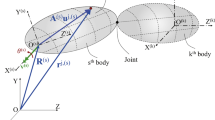Abstract
Although various studies on reduced-order modeling (ROM) of flexible multibody dynamics have been conducted, the issue of efficiency still exists. Significant computational resources are required in order to handle rigid body motions and inertia forces along with the flexibility of each body. The absolute nodal coordinate formulation (ANCF) uses only the absolute values in global coordinates to describe the flexible motions of multibody dynamics. While the other conventional formulations have nonlinearities in mass matrices and inertia forces, the nonlinearities are concentrated in the internal forces in the ANCF formulation, which is analogous to the equations of nonlinear structural dynamics. This enables ANCF approaches to embrace the various ROM techniques that have been developed for nonlinear structural analysis. This paper adopts stiffness evaluation methods, which represent nonlinear internal forces as the sums of third-order polynomial displacements, in order to enhance the efficiency of the ANCF approach. A stiffness evaluation method based on element connectivity is proposed to improve the low efficiency of the conventional method and is combined effectively with an ROM technique without loss of accuracy. The proposed reduction method, which is referred to as SEECROM, is utilized smoothly with ANCF beam elements. A number of examples including a four-bar mechanism are demonstrated to verify the efficiency and accuracy of the proposed method.




















Similar content being viewed by others
References
Muravyov, A.A., Rizzi, S.A.: Determination of nonlinear stiffness with application to random vibration of geometrically nonlinear structures. Comput. Struct. 81, 1513–1523 (2003). doi:10.1016/S0045-7949(03)00145-7
Shabana, A.A.: Flexible multibody dynamics: review of past and recent developments. Multibody Syst. Dyn. 1, 189–222 (1997). doi:10.1023/A:1009773505418
Escalona, J.L., Hussien, H.A., Shabana, A.A.: Application of the absolute nodal co-ordinate formulation to multibody system dynamics. J. Sound Vib. 214, 833–851 (1998). doi:10.1006/jsvi.1998.1563
Yakoub, R.Y., Shabana, A.A.: Use of Cholesky coordinates and the absolute nodal coordinate formulation in the computer simulation of flexible multibody systems. Nonlinear Dyn. 20, 267–282 (1999). doi:10.1023/A:1008323106689
Berzeri, M., Shabana, A.A.: Development of simple models for the elastic forces in the absolute nodal co-ordinate formulation. J. Sound Vib. 235(4), 539–565 (2000). doi:10.1006/jsvi.1999.2935
Shabana, A.A.: Dynamics of Multibody Systems. Cambridge University Press, Cambridge (2013)
Gerstmayr, J., Ambrósio, J.A.C.: Component mode synthesis with constant mass and stiffness matrices applied to flexible multibody systems. Int. J. Numer. Methods Eng. 73, 1518–1546 (2008). doi:10.1002/nme.2133
Iwai, R., Kobayashi, N.: A new flexible multibody beam element based on the absolute nodal coordinate formulation using the global shape function and the analytical mode shape function. Nonlinear Dyn. 34, 207–232 (2003). doi:10.1023/B:NODY.0000014560.78333.76
Kobayashi, N., Wago, T., Sugawara, Y.: Reduction of system matrices of planar beam in ANCF by component mode synthesis method. Multibody Syst. Dyn. 26(3), 265–281 (2011). doi:10.1007/s11044-011-9259-6
Sun, D., Chen, G., Sun, R.: Model reduction of a multibody system including a very flexible beam element. J. Mech. Sci. Technol. 28(8), 2963–2969 (2014). doi:10.1007/s12206-014-0703-4
Sun, D., Chen, G., Shi, Y., Wang, T., Sun, R.: Model reduction of a flexible multibody system with clearance. Mech. Mach. Theory. 85, 106–115 (2015). doi:10.1016/j.mechmachtheory.2014.10.013
Golub, G.H., Van Loan, C.F.: Matrix Computations, 3rd edn. Johns Hopkins University Press, Baltimore (1996)
Sirovich, L.: Turbulence and the dynamics of coherent structures. I—coherent structures. II—symmetries and transformations. III—dynamics and scaling. Q. Appl. Math. (ISSN 0033-569X), 45(July), 561 (1987)
Breuer, K.S.: The use of the Karhunen–Loève procedure for the calculation of linear eigenfunctions. J. Comput. Phys. 96(2), 277–296 (1991). doi:10.1016/0021-9991(91)90237-F
Liang, Y.C., Lee, H.P., Lim, S.P., Lin, W.Z., Lee, K.H., Wu, C.G.: Proper orthogonal decomposition and its applications–part I: theory. J. Sound Vib. 252(3), 527–544 (2002). doi:10.1006/jsvi.2001.4041
Lee, J.: Proper orthogonal decomposition-based parametric reduced order models for structural analysis and design optimization. Ph.D. Dissertation, Seoul National University (2015)
Acknowledgments
This work was supported by a National Research Foundation of Korea (NRF) Grant funded by the Korean government (MSIP) (No. 2012R1A3A2048841).
Author information
Authors and Affiliations
Corresponding author
Rights and permissions
About this article
Cite this article
Kim, E., Kim, H. & Cho, M. Model order reduction of multibody system dynamics based on stiffness evaluation in the absolute nodal coordinate formulation. Nonlinear Dyn 87, 1901–1915 (2017). https://doi.org/10.1007/s11071-016-3161-y
Received:
Accepted:
Published:
Issue Date:
DOI: https://doi.org/10.1007/s11071-016-3161-y




